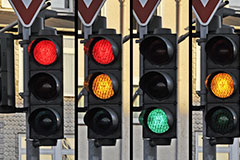Why are Traffic Lights Red, Yellow and Green? - Vol.413
We were familiar with the color scheme of traffic lights way before we learned how to drive. In fact, it's one of the first things we've ever noticed while walking or driving around town. But why red, yellow and green? They might as well have used any other color, right?

Well, not exactly. The truth is, these are not just random colors, and there's a good explanation for why traffic lights look the way they do today. In this article, we'll show you what led to these exact colors telling us when to stop and when to drive.
The First Traffic Light System
The color scheme we see on traffic lights today is derived from a system that railroad companies developed in the 19th century. They used it as a signal for train engineers to stop and go. Even then, red was a signal that meant 'stop'. After all, it is the color that's been used to represent danger in different situations beyond just driving.
What was different, though, is the choice of colors for caution, which was green at the time, as well as the 'go' light, which was white. Although this was working for some time, it turned out that white wasn't a very good choice. There was an incident where the red lens fell down and left the white light exposed, which led to two trains crashing.
Since then, the green light has been used as a signal for moving forward, and yellow as a signal for caution. The reason why the railroad company chose yellow was the fact that it can be easily distinguished from the other two colors.
Road Traffic Lights
The first traffic light system like the one we know it today was invented by William L. Potts, a police officer in Michigan, in 1920. He invented it in order to fix the problem of car accidents caused by an increasing number of cars on the streets. He used red, amber, and green lights to construct the first four-way traffic light, which was installed in Detroit.
A couple of years later, automated versions of Pott's invention emerged. The first systems were very simple, with the lights changing at predetermined time intervals. However, this system had a big drawback of keeping cars in one place even when there were no vehicles coming from a different direction.
To solve this problem, Charles Adler Jr. invented a traffic light with a built-in microphone that could register a car's honking. Whenever a driver wanted to pass through, he would just honk and the light would change. Of course, it wouldn't make much sense for the light to change continuously, so once it turned on, it wouldn't change for 10 seconds.
Although this was convenient for drivers, you can imagine how the people living in homes close to these lights felt. For that reason, Henry A. Haugh invented a system that used metal strips. There were two of them, and when a car pushed them together, the light would change and allow it to pass through.
Uniform Traffic Lights
The problem with the systems we mentioned above is that they caused confusion, since different systems were used in different places. To solve this issue, the Federal Highway Administration created a document called "The Manual on Uniform Traffic Control Devices" in 1935. This document set universal standards for traffic lights, as well as other road signs and signals, and they kept red, yellow, and green as the colors of all traffic lights.
To this day, a lot of modifications have been made to the technologies that traffic lights use, but the one thing that always stays the same is the colors. We seem to have gotten used to them, so they're likely to stay the same in the future.